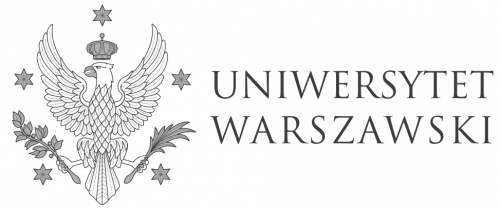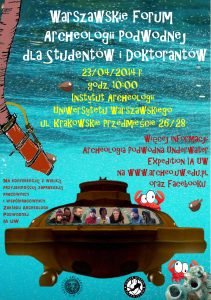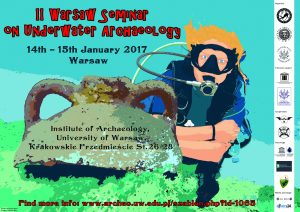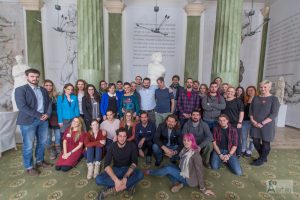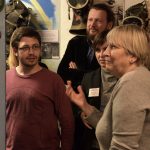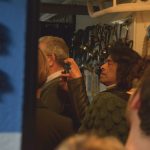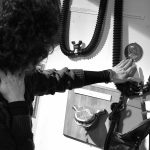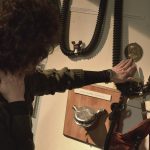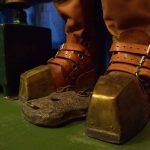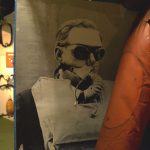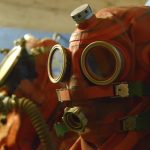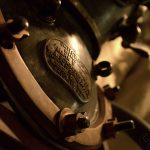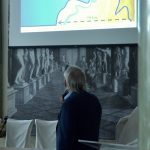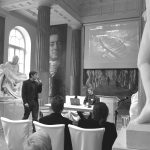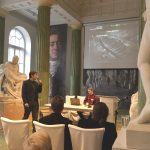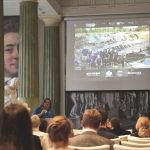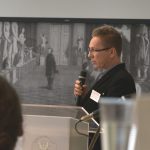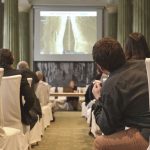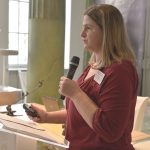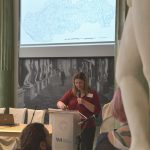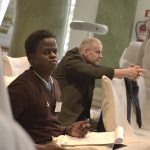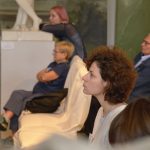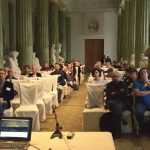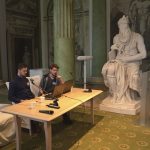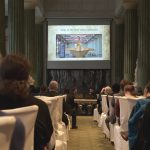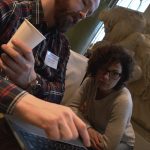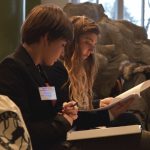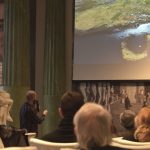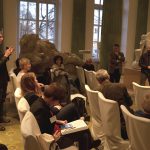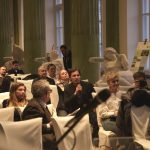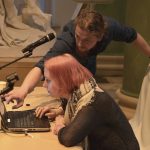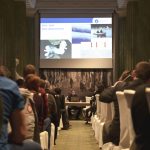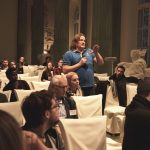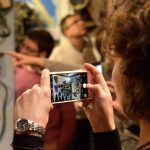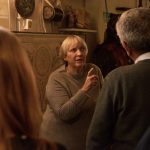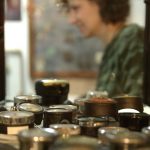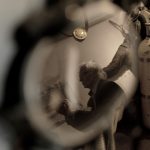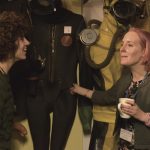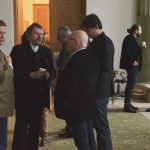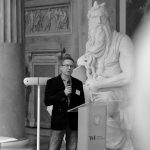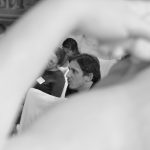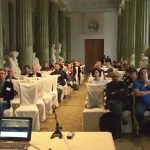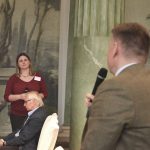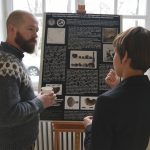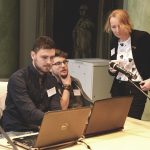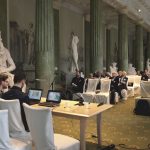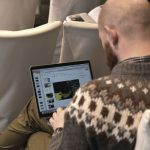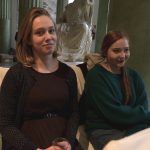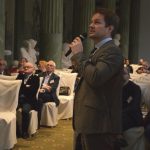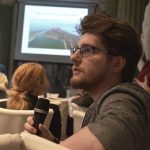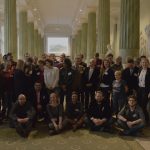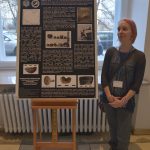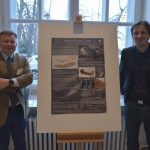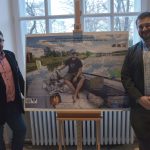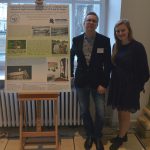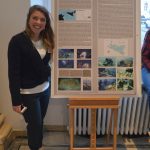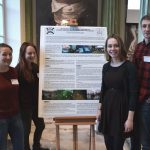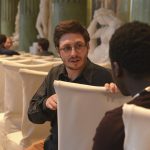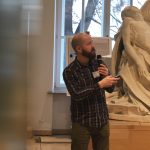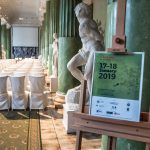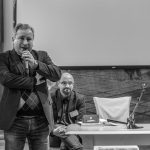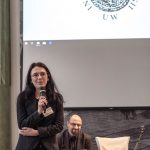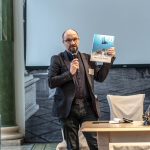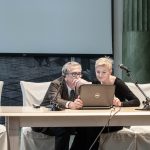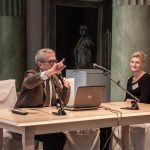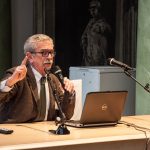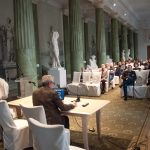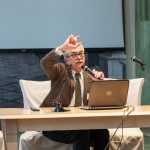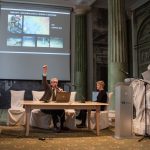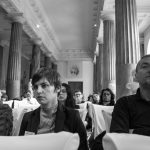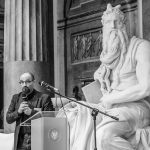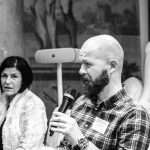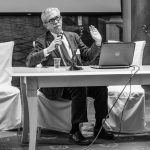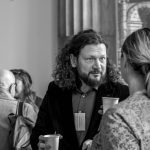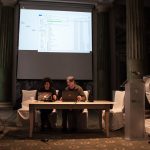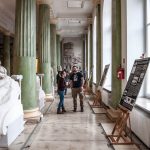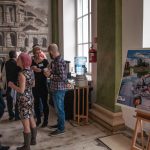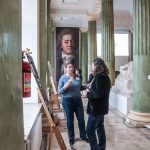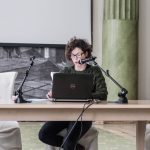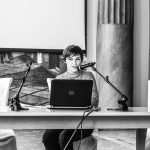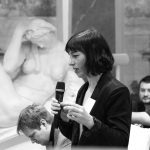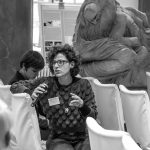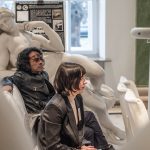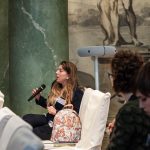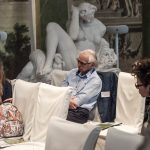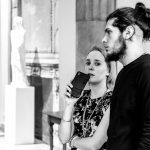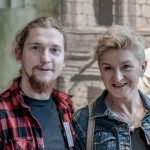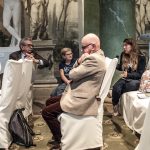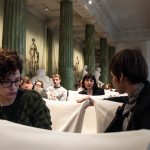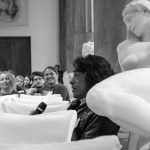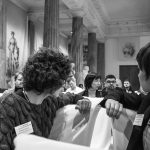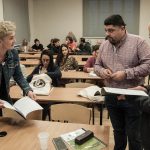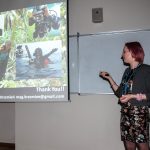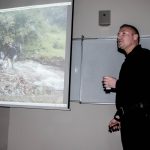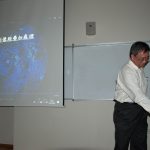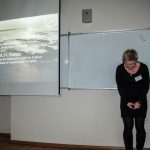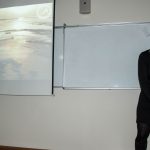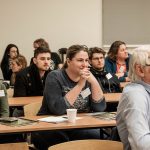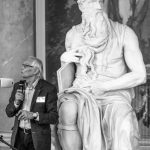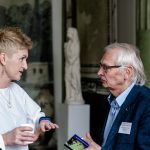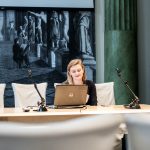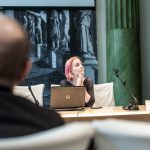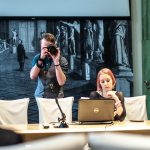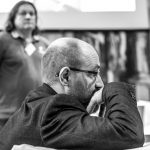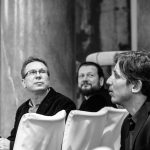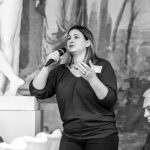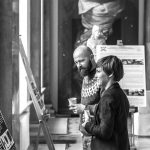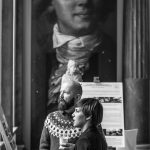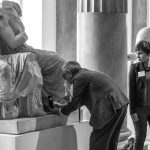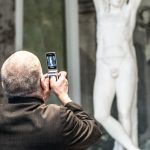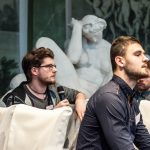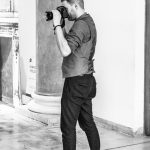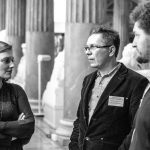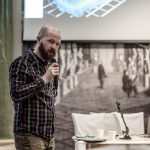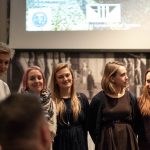3rd Warsaw Seminar on Underwater Archaeology
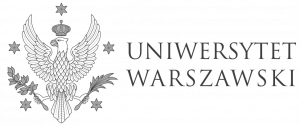
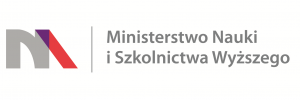
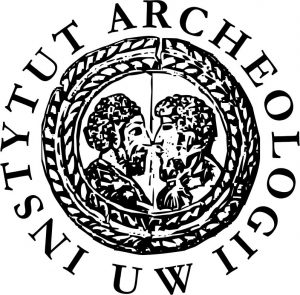
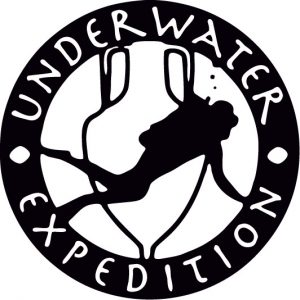
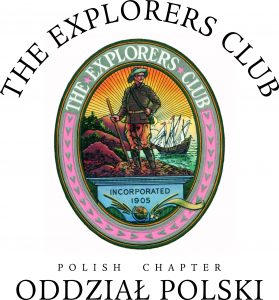
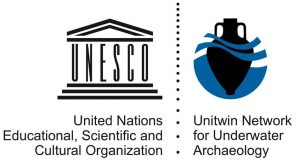
17th – 18th January 2019, Warsaw
On behalf of the Department of Underwater Archaeology,
Institute of Archaeology, University of Warsaw, we are pleased
to invite you to the 3rd Warsaw Seminar on Underwater Archaeology. The conference will take place on 17th – 18th January 2019 in Warsaw (Krakowskie Przedmieście 26/28).
The speakers are welcome to present the latest information from fieldwork, archive studies, as well as concerning the newest technologies, their influence on underwater archaeology methods and, above all, the activities of certain museums and universities in the field of protection of underwater cultural heritage.
The official language of the conference is English.
The maximum length of presentation is 20 minutes.
Proposals for posters are also welcome.
Feedback with further data will be sent after receiving the application.
Please send Your application to: underwaterexpedition@uw.edu.pl until 4th November 2018.
The registration for the listeners (also via application form) is available until 30th November 2018.
The conference fee is 30 Euro.
The reduced conference fee is 20 Euro (students only).
You will be asked to pay the fee until the 15th November 2018,
after the application is accepted.
Please note, that we provide the possibility to publish the conference paper in “Światowit” Suppl. Series “U”, vol. 2. The deadline for submitting the papers is 30th December 2018. The instructions for the authors will follow shortly.
PROGRAMME OF THE CONFERENCE
DAY 1
17.01.2019
(VENUE: the Column Hall, Faculty of History)
8:30 – 9:30 REGISTRATION
9:30 OPENING
10:00 KEYNOTE SPEECH
Iván Negueruela Martínez
(Museo Nacional de Arqueología Subacuática, Cartagena)
Underwater Archaeology in Very Deep Waters: the Three Campaigns
(2015–2017) in the Wreck “Mercedes”, 1138 m depth
10:30 Discussion
Coffee Break
PANEL I: Mediterranean
11:00 Evgenia Loizou (Christian-Albrechts-Universität, Kiel)
The Landscape of the Bronze Age Harbours in the Aegean
11:20 Jessica Frischetti (School of Specialization in Archeological Heritage of the University of Catania)
Sicily and Seas: the Ancient Trade. The Case of the Shipwreck of Gela
11:40 Jelena Celebic (Center for Conservation and Archaeology of Montenegro)
The Development of Harbours on Eastern Adriatic coast in Antiquity:
Revisiting Assumptions with new Evidence
12:00 Paulina Komar (Institute of Archaeology, Jagiellonian University in Kraków)
Greek Wine Amphorae Underwater Discoveries
12:20 Vyacheslav Gerasimov (Institute of Archaeology NAS Ukraine, Kyiv)
Research of the Black Sea International Underwater Archaeological Expedition
in Ukraine in 2018. Discovery of an Ancient Shipwreck from the late 4th–early 3rd century BCE
12:40 Joseph M. Pacheco Jr. (University of Haifa)
Piracy in the Hellenistic Period: A Misunderstood Phenomenon
13:00 Discussion
13:30 Lunch Break
(VENUE: room 209, 2nd floor, Institute of Archaeology)
14:30 KEYNOTE SPEECH
Finn Ole Nielsen and M. Nicolas Caretta
(Bornholm Archaeological Research Center, Bornholm Museum)
Bornholm’s Underwater Heritage
15:00 Discussion
Coffee Break
PANEL II: Beyond Europe
15: 20 Magdalena Krzemień (Institute of Archaeology, Jagiellonian University)
Bernard Hermes (Petén Itzá Project co-Director)
Jakub Maciejewski (ANCHOR)
Małgorzata Mileszczyk (Institute of Archaeology, University of Warsaw)
Mateusz Popek (Institute of Archaeology, Nicolaus Copernicus University in Toruń)
Results of the Underwater Reconnaissance in Lake Petén Itzá in Northern Guatemala
15:40 Przemysław A. Trześniowski, Maciej Sobczyk (Centre for Precolumbian Studies, University of Warsaw)
Mateusz Popek (Institute of Archaeology, Nicolaus Copernicus University in Toruń)
Don’t Mess with the Apus – Technical & Safety Aspects of the High-Mountain Underwater Archaeology
16:00 Wen-Miin Tian (National Sun Yet-sen University, Kaohsiung City, Taiwan)
Surveying of Underwater Cultural Heritage: Status of General No.1 and Warship Guang Bing
16:20 Magdalena Nowakowska (Faculty of History, University of Warsaw)
Sa’idah Bay: Between Tradition and Modernity. A Contribution to the Study
of the Tidal Zone’s Fishing Infrastructure around Failaka Island in the Arabian Gulf in Kuwait
16:40 Mouhamet Traoré (Laboratoire d’archéologie université Cheikh Anta diop de Dakar/ Collegium Historicum Adam Mickiewicz University of Poznań)
Underwater Archaeology in Senegal: Relevance and Impact on Historical Research and Management of Cultural Heritage
17:00 Discussion
DAY 2
18.01.2019
(VENUE: the Column Hall, Faculty of History)
10:00 KEYNOTE SPEECH
Vladas Žulkus (Klaipėda University)
Investigations of Lithuanian Archaeologists on the Baltic Sea Bottom
10:30 Discussion
Coffee Break
PANEL III: Rivers
10:50 Waldemar Ossowski, Michał Grabowski (University of Gdańsk)
Wojciech Borkowski (State Archaeological Museum in Warsaw)
Shipwreck from Czersk. Excavation of the Large Vistula River Vessel
from the Medieval Times
11:10 Piotr Maliński (Institute of Political Science and European Studies, University of Szczecin)
Underwater Ethnoarchaeology of the Lower Oder. Preliminary Research on Shipwrecks in Selected Sections of the River
11:30 Klaudia Daňová, Jana Stehlíková (Institute of Archaeology, Slovak Academy of Sciences)
Miroslava Daňová (Departament of Classical Archaeology, University in Trnava)
Significant Crossroads at the Lower Reaches of the River Váh. Preliminary Report
11:50 Discussion
Coffee Break
12:10 Miroslava Daňová, Martin Zázik, Matúš Barbuščák (Departament of Classical Archaeology, University in Trnava)
Ports and Fleet in Roman Carnuntum. A Hypothetical Reconstruction
12:30 Martin Lemke (Antiquity of Southeastern Europe Research Centre, University of Warsaw)
Marta Bajtler (Institute of Mediterranean and Oriental Cultures Polish Academy of Science)
Karolina Trusz (Institute of Archaeology, University of Warsaw)
The Danube Underwater Heritage Project – Status Quaestionis 2018 and Plans
for the Future
12:50 Discussion
13:30 Lunch Break
15:00 POSTER PRESENTATION
(VENUE: the Column Hall, Faculty of History)
Angela Accardi (Superintendency of the Sea of Sicily)
New Systems to Protect the Underwater Cultural Sites of Sicily
Artur Brzóska (Institute of Archaeology, University of Warsaw)
Piotr Prejs (Stowarzyszenie Archeologów Jutra)
Verification and Photogrammetric Documentation of the Archaeological Site in Boczne Lake
Michał Grabowski, Waldemar Ossowski (University of Gdańsk)
Wojciech Borkowski (State Archaeological Museum in Warsaw)
Shipwreck from Czersk. Excavation of the Large Vistula River Vessel from the Medieval Times
Piotr Maliński (Institute of Political Science and European Studies, University of Szczecin)
Sławomir Radaszewski (Nurek – Technika Company)
Przemysław Krajewski (Chair of Archaeology, University of Szczecin)
A Wreck from Porzecze – a Relic of the Battle of the Oder River in 1945
Piotr Maliński (Institute of Political Science and European Studies, University of Szczecin)
Przemysław Krajewski (Chair of Archaeology, University of Szczecin)
Sławomir Radaszewski (Nurek – Technika Company)
Kamila Gutkowska (Independent Researcher)
Underwater Memorabilia of World War II – a Military Boat Wreck of Light Pontoon Bridge Park NLP and its Cargo
Małgorzata Mileszczyk (Institute of Archaeology, University of Warsaw)
Lake Grid Dwelling in Rybno, Piłakno Lake (Mrągowskie Lakeland, Poland). New Ideas
for Interpretation of the Lake Dwelling Phenomenon
Zuzanna Lachowicz, Katarzyna Pilaszek, Elżbieta Łuba, Krzysztof Cetwiński
(Institute of Archaeology, University of Warsaw)
The History of the University of Warsaw’s Student Association for Underwater Archaeology
PANEL IV: Baltic Sea, North Atlantic, Northern Europe
15:30 Kevin Martin (University of Iceland)
Melckmeyt – An Underwater Archaeological Survey of a 17th-century Shipwreck
in Iceland
15:50 Jonas Enzmann (Lower Saxony Institute for Historical Coastal Research)
The Current Underwater Excavations at the Mesolithic Site of Strande LA 163, Schleswig-Holstein, Germany
16:10 Discussion
Coffee Break
16:30 Andrzej Pydyn, Mateusz Popek (Department of Underwater Archaeology, Nicolaus Copernicus University in Toruń)
Last 5 Years of Underwater Research in the Department of Underwater Archaeology, Nicolaus Copernicus University in Toruń
16:50 Bartosz Kontny, Dawid Rembecki (Institute of Archaeology, University of Warsaw)
Axes from the Lubanowo Lake and their Possible Function on the Background
of Watery Finds of the Roman Period and Middle Ages
17:10 Artur Brzóska (Institute of Archaeology, University of Warsaw)
Piotr Prejs (Stowarzyszenie Archeologów Jutra)
Underwater Photogrammetric Documentation at Two Archaeological Sites: Bogaczewo and Niedzięgiel Lake
17:30 Discussion
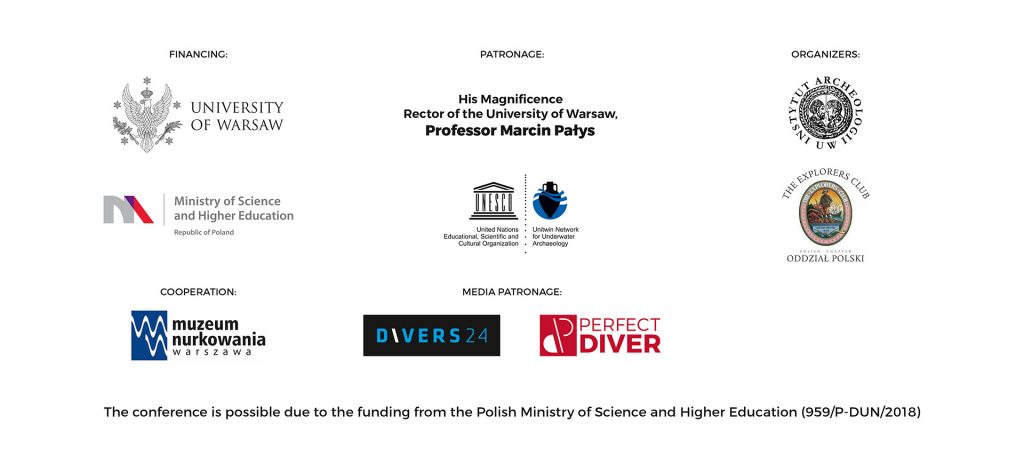
„3rd Warsaw Seminar on Underwater Archaeology” – zadanie finansowane w ramach umowy Nr 595/P-DUN/2018 ze środków MInistra Nauki i Szkolnictwa Wyższego przeznaczonych na działalność upowszechniającą naukę”
Underwater Archaeology in Very Deep Waters: the Three Campaigns (2015–2017) in the Wreck “Mercedes”, 1138 m depth
Iván Negueruela Martínez
(Museo Nacional de Arqueología Subacuática, Cartagena)
In 2007, Odyssey Marine Exploration, a Company of treasure hunters from USA, announced in a press conference that they had located
„in international waters” a ship „predictably English”, and that had „recovered” and transferred to Tampa (Florida) 600,000 silver coins.
The Spanish Government started inquiries and discovered that it was
a Spanish ship: Nuestra Señora de las Mercedes (currently, „NSM”), sunk by the Royal Navy on October 5, 1804, in a clearly ’illegal pirate attack’.
The US Supreme Court ordered Odyssey to return to Spain everything that had been spoiled.
The ship was sunk 1138 m deep in the Atlantic, off the coast of Portugal. Aware of the enormous difficulty, I proposed the Ministry of Culture
to organize a Project to inspect, document, and excavate the remains
of the ship, following the Rules of the Annex of the UNESCO Convention of Paris 2001.
So, the first Campaign was held in 2015. Given the success of it,
we have done two more campaigns: 2016 and 2017. Presumably, the first excavation in those “very deep” waters.
The challenges, technology, methodologies and results obtained will be briefly discussed.
Bornholm’s Underwater Heritage
Finn Ole Nielsen and M. Nicolas Caretta
(Bornholm Archaeological Research Center, Bornholm Museum)
Throughout the years, the Bornholm Museum has shown interest for submerged ancient landscapes and settlements, as well as ports and shipwrecks along the shoreline in collaboration with other Government agencies and the academic institutions. Explorations have also been carried out at various places along the coasts to locate ancient settlements, ports, trading centers and structures related to maritime activities. The discoveries confirm Bornholm’s rich submerged cultural heritage and the importance of its conservation.
A humble beginning has been made in this direction and more efforts and collaboration is required before this submerged heritage is destroyed owing to intense activity along the coast, resulting from globalization and rapid industrialization along the Baltic Sea.
This presentation provides an overview of developments in Bornholm underwater archaeology and describes a few important sites and their archaeological significance.
Investigations of Lithuanian Archaeologists on the Baltic Sea Bottom
Vladas Žulkus (Klaipėda University)
During the last decade, underwater investigations took place in two directions. The first activity is the search and research of shipwrecks underwater and gathering information about shipwrecks. Other activities are aimed at the location and research of submerged prehistoric landscapes.
There are ongoing discussions about the management of shipwrecks and submerged prehistoric cultural heritage.
The marine underwater investigation methods have also been adapted to search for objects in inland waters.
We are happy to present this year topics.
Speakers and poster Authors are listed in the alphabetical order.
New Systems to Protect the Underwater Cultural Sites of Sicily
Angela Accardi
The Superintendency of the Sea of the Sicily Region (Soprintendenza del Mare – Regione Siciliana), first and only in Italy, has been implementing the 2001 UNESCO Convention since its establishment in 2004. In the seas of Sicily and its smaller islands many sites have been identified using the most modern technologies, also through agreements with foreign foundations. Twenty-three underwater cultural routes opened to the public have been established. The use of these sites has been activated with sophisticated modern technologies. All this will be illustrated in the poster which is proposed for the Seminar.
The Danube Underwater Heritage Project – status quaestionis 2018 and plans for the future
Martin Lemke, Marta Bajtler, Karolina Trusz
The Danube Underwater Heritage Project was started in 2017 as the result of a cooperation agreement between the Eco-Museum Research Institute ‘Gavrila Simion’ in Tulcea, Romania and the Antiquity of Southeastern Europe Research Centre of the University of Warsaw. The overall idea is to examine and assess archaeological remains at the bottom of the Danube River in its delta, the nearby Razim-Sinoe Lagoon, and selected spots on the Romanian Black Sea coastline. An important scientific problem is the evaluation of the sediment in the river delta and the resulting limitations for underwater investigations.
Around the Black Sea, significant settlements appeared during the Greek colonization. There is a well-grounded theory that Rome chose to include the area currently known as Dobrudja for reasons of logistical security. It was crucial to control the Lower Danube on its entire length. As a result, more army camps were built along the last stretch of the Danube between the Yantra tributary and the river delta, facilitating even more intense ship traffic and connecting the Greek cities, which functioned as supply bases.
The first season of the non-invasive underwater project took place in September 2017, when various sites within the Danube Delta were verified. The prospection included Bazinul Mare (a reservoir on the Sulina estuary), Lake Sinoe adjacent to ancient Histria and Lake Razim on which ancient Argamum was located. The next campaigns will focus on the Black Sea coastal waters between the mouths of the two Danube branches: Sulina and Saint George (Sfântu Gheorghe).
Ports and Fleet in Roman Carnuntum. A Hypothetical Reconstruction
Miroslava Daňová, Martin Zázik, Matúš Barbuščák
The aim of the paper is to bring a hypothetical reconstruction of the Carnuntum ports and the fleet operating on the Danube River. The comprehended area referred to as Carnuntum includes the Roman era a military camp, civilian town, palace of the governor and their hinterland.
The location and reconstruction of the Roman port is based on a comparison of information from the physical geography, Roman urbanism, archaeological research, and published results of geophysical surveys.
In the hypothetical reconstruction of the fleet that was part of Classis Pannonica, the authors took into account the geographical expansion of the fleet, its development and the analogy of Roman vessels from other European rivers.
Shipwreck from Czersk. Excavation of the Large Vistula River Vessel from the Medieval Times
Michał Grabowski, Waldemar Ossowski, Wojciech Borkowski
During the summer of 2018, remains of a wooden shipwreck were excavated from an old riverbed in Czersk (Masovian Voivodeship, Poland). The recovered wreck is one of the largest examples of sailing vessels used on the Vistula River in the pre-industrial era. The shipwreck was in a very good condition. Its port side has been preserved up to the gunwale and the stern part was almost intact. The total length of the vessel was estimated up to 30 m with the original width of about 7–8 m. The hull preserved in almost 70% of its original form, with the intact aft part. The port side of the vessel was partially preserved up to the gunwale. The dendrochronological analysis has revealed that the timbers used for construction came from trees felled between 1478 and 1481 in area of Gdańsk. The whole construction was in use for almost 60 years before it was scuttled along the shoreline of the Vistula River.
The presentation shows the results of two-week operation, where the preserved construction of the vessel was excavated, documented and extracted from the site. The archaeological works were conducted by the State Archaeological Museum in Warsaw in cooperation with Archcom – Archaeological and Commercial Diving Services – and support of the University of Gdańsk.
Underwater Photogrammetric Documentation at Two Archaeological Sites: Bogaczewo and Niedzięgiel Lake
Verification and Photogrammetric Documentation of the Archaeological Site in Boczne Lake
Artur Brzóska, Piotr Prejs
Underwater photogrammetry has become very popular all over the world, and the documentation of archaeological sites with this technique slowly becomes the standard. The speakers will present two examples of such documentation in case of two archaeological sites documented by members of the Association of Archaeologists of Tomorrow (SAJ) and Institute of Archaeology, University of Warsaw along with the Student Association for Underwater Archaeology in the past year.
The first example are the remains of the settlement from the 620–450 BCE, located in Boczne Lake. The documentation has been made using the SFM (Structure from Motion) photogrammetric technique, based on which a detailed residual settlement plan was developed, as well as the digital terrain modelling along with a 3D model.
The second described example is a dugout from Niedzięgiel Lake, which was documented photogrammetrically in 2017 and on the basis of 1517 mutually overlapping photographs a detailed 3D model of the preserved object was created along with orthomosaics.
The Development of Harbours on Eastern Adriatic coast in Antiquity: Revisiting Assumptions with new Evidence
Jelena Celebic
Harbours were the heart of ancient trade, maritime gates towards unknown worlds and people. They were strictly dependent on the agricultural productions of the territory to which they belong and, on the other hand, directly connected to maritime and fluvial activities. The activity of the harbours, thanks to their favourable conditions, continues for centuries until their complete destruction.
Due to the sea currents and numerous islands, maritime traffic at the Adriatic in Antiquity mainly followed the eastern Adriatic coast, which means that the existence of appropriate harbours was indispensable.
Ancient Adriatic harbours, the majority of them, were adapted to the natural conditions of the place they were built on. The first type of harbours on the Adriatic cost is characterized by natural piers, where the installations followed coastal configuration (Vis, Kolent, Polade etc.). The second type is characterized by built structures (Zaton, Biograd, Polačine, Janice, Savurdija, Veštar etc).
In addition to the traditional methodology, in this research the LiDAR data will be used, in order to facilitate the identification of harbours. Obtained data will be verified with underwater surveys.
The study of the system of harbours in the Eastern Adriatic coast could yield a lot of new information about the disposition of production centres, the maritime routes, and their connection with hill-fort settlements, villae rusticate etc.
The History of the Warsaw University’s Student Association for Underwater Archaeology
Zuzanna Lachowicz, Katarzyna Pilaszek, Elżbieta Łuba, Krzysztof Cetwiński
Recently the Student Association for Underwater Archaeology has celebrated the 5th anniversary of foundation. The association was established in May 2013 as a continuation of previous activities undertaken by students from the University of Warsaw interested in this field of research. Since the beginnings, the members of the club have carried out multiple students projects concerning dugout boats, lake grid settlements, bridges, sacrificial sites, and verification of the state of degradation of already confirmed archaeological sites. As a result of those projects, the extensive documentation was provided, including photography and 3D models. In order to share the results of the research, numerous papers in the popular periodical Archeo UW were published and the exhibitions were also organized at the University and museums. Moreover, the Student Association for Underwater Archaeology has taken part in a wide variety of events focused on promoting archaeology, like the annual Science Picnic in Warsaw, Archaeologist Day at UW and the Archaeological Festival in Biskupin.
Significant Crossroads at the Lower Reaches of the River Váh. Preliminary Report
Klaudia Daňová, Miroslava Daňová, Jana Stehlíková
The Váh is the longest Slovak river. At least from the Middle Ages it has been both an important traffic artery and a border which separated two banks that had to be connected with a bridge. For this purpose, fords, ferries, and bridges were used and the remains of these structures are still visible at some points when the water level is low. This paper will focus on the mapping of important traffic hubs at the lower reaches of the Váh River (Sereď, Šintava, Hlohovec) and a look at their current conditions and informative value. In particular, the area of the Váh near the town Hlohovec, where numerous round structures are visible to the naked eye, attracts attention and in recent times has become a part of unwanted interest and interference from the public. In order to save as much information as possible, the attention of several scientific teams has, in recent years, begun to concentrate on the remains of the medieval (?) bridge.
The contribution is created with the support of the VEGA grant (2/0146/18) Fords, bridges, long-distance roads. Ancient communications and settlements in Považie and Ponitrie.
The Current Underwater Excavations at the Mesolithic Site of Strande LA 163, Schleswig-Holstein, Germany
Jonas Enzmann
The site Strande LA 163 was discovered in 2011 at 6 m depth by two professional divers, who found several large fallen oak trunks. In 2012 and 2014 a test excavation and a survey were conducted on the periphery of the oak trunks. As a result of these surveys done by Dr. Julia Goldhammer it was clear that the site had very promising preservation conditions and that the material found could be dated between 5300 and 4700 BCE. It thus belongs to the aceramic phase of the Ertebølle Culture, about which very little is known in the south-western Baltic Sea area. The site was situated at the shoreline of an inlet, lagoon or small lake close to the open sea.
In 2018 the Lower Saxony Institute for Historical Coastal Research (NIhK) started a project funded by the German Research Foundation about the subsistence strategies, communication, and settlement structures in the aceramic period of the Ertebølle Culture. Until now two diving campaigns of a total of 13 weeks had taken place at the site. The lecture will present the first results of these excavations and the special measurement and documentation methodologies used for an extremely accurate excavation.
Sicily and Seas: the Ancient Trade. The Case of the Shipwreck of Gela
Jessica Frischetti
From the research studies on the ancient trade emerges the necessity of addressing the development of Sicily in the Archaic Period. In those times Sicilian cities had experienced the age of great growth, which has originated from a strong agricultural exploitation that influenced the economic development. That has increased the trade, underlining the crucial role of this island already in the Archaic Period, both for the communication of different cultures and various kinds of product exchange. Another reason why Sicily played an important role in the archaic trade was its geographical position as a crucial point for communication and commerce from the Orient to the Occident and vice versa. One important proof of its importance in the Archaic Period is the archaeological find of a Greek shipwreck in the proximity to Gela. One of three ships is important not only due to its artefacts, but also for its characteristic construction techniques, unusual for the archaic commerce.
Research of the Black Sea International Underwater Archaeological Expedition in Ukraine in 2018. Discovery of an Ancient Shipwreck from the Late 4th–early 3rd century BCE
Vyacheslav Gerasimov
In the 2018 season the Black Sea International Underwater Archaeological Expedition of the Institute of Archaeology, National Academy of Sciences of Ukraine (Kyiv) and the Institute of Archaeology, University of Warsaw (Poland) conducted underwater archaeological works in shelf waters of the Black Sea around Tendra Spit (Kherson region) and Kinburnska Spit (Mykolaiv region).
Four underwater objects were revealed at depths from 3 to 12.5 m on the seabed of the Tendra Spit area.
In the area of Kinburnska Spit an ancient shipwreck of the late 4th–early 3rd century BCE was discovered and explored. It was possible to find a well-preserved wooden ship hull of 9.45 m in length, with ballast stones and ceramic material from the cargo, lead sheath and some elements of the ancient sailboat.
Greek Wine Amphorae Underwater Discoveries
Paulina Komar
The aim of this presentation is to investigate chronological and geographical distribution of shipwrecks that carried Greek wine amphorae. This is in order to check what the commercial trends in Greek wines in different areas of the Mediterranean in different periods of time were.
It will show that Aegean wine amphorae were not equally popular throughout the Mediterranean. Most of them were discovered in its eastern parts, the surroundings of the Apennine Peninsula, as well as the south coast of France.
Two shifts in Greek wine amphorae forms may be observed: from north to south Aegean around the 3rd century BCE and to containers from the western Asia Minor throughout the 3rd century CE. Most of the shipwrecks that carried Greek wine amphorae date to the 1st century BCE and the 1st century CE, which suggests that Greek wine trade was most intensive during this period.
Axes from the Lubanowo Lake and their Possible Function on the Background of Watery Finds of the Roman Period and Middle Ages
Bartosz Kontny, Dawid Rembecki
In the small lake at Lubanowo (NW Poland) numerous interesting items were discovered, both by chance and during regular surveys. Apart from weapons and tools dated to the Roman Period some medieval specimens have also been found here, i.a. the axes. Together with the Roman Period axes and adzes they create a collection of ca 10 specimens which may be treated as carpenters’ utensils. But is that interpretation correct? The speakers will try to answer the question of the plausible function of the items but also to analyse the phenomenon of similar finds from waters (mostly lakes) from the Roman Period and Middle Ages. Whereas for the former period the idea of sacrificial deposits is used most frequently, the medieval axes were treated as the losses connected with building some wooden structures situated close to lakeshores. However, new ideas have been presented lately in that field, underlining certain sacral acts to explain the Middle Ages watery finds of tools and weapons. The position of the Lubanowo finds allows falsifying some of possible interpretations.
Wreck from Porzecze – a Relic of the Battle of the Odra (Oder) River in 1945
Piotr Maliński, Sławomir Radaszewski, Przemysław Krajewski
Over a dozen years ago the divers penetrating the oxbow lakes of the Odra (Oder) River in Landscape-Nature Protected Complex ‘Porzecze’ had discovered a steel wreck of a flat-bottomed vessel above 5 m long. The find had been interpreted as a German cargo boat from the first half of the 20th century and had not attracted attention of scientists.
In 2016, academics from the University of Szczecin, together with diving expert from the NUREK-TECHNIKA company have thoroughly reinvestigated the wreck, taking side-scan sonar images and measurements. It has become possible to correctly identify the wreck as an element of Soviet heavy pontoon bridge park N2P (тяжёлый понтонныйпарк Н2П). It was a mobile set of military engineering equipment designed for construction of ferries and floating bridges, introduced to the Red Army service in 1932. The vessel has sunk or was sunken during fights along the Odra River, fought between the Red Army and armed forces of Nazi Germany in winter and spring of 1945. The wreck is preserved in good condition, though all removable parts are missing.
The wreck, now examined and documented, is currently the only known specimen of this type of vessel in Poland. It remains an interesting element of cultural heritage of the Odra valley, enriching natural assets of ‘Porzecze’ Complex.
Underwater Memorabilia of World War II – a Military Boat Wreck of Light Pontoon Bridge Park NLP and Its Cargo
Piotr Maliński, Przemysław Krajewski, Sławomir Radaszewski, Kamila Gutkowska
Among the engineering equipment of the Red Army there was a light pontoon bridge park NLP (НЛП, наплавнойлёгкийпарк). It enabled the construction of ferries and floating bridges of bearing capacity up to 16 tons. The park included 28 foldable pontoons (boats) constructed of wood and steel, above seven-meters-long. NLP parks were also used by the Polish Army during crossing the Odra (Oder) River in spring of 1945.
A wreck of such pontoon was found in the river branch. In 2015–2016, scholars from the University of Szczecin together with divers from NUREK-TECHNIKA company performed underwater archaeological research of the find. Fragments of the wreck were excavated along with artefacts discovered inside, which after conservation were exhibited in the Museum of 1st Polish Army Memorabilia and History of Mieszkowice Land.
The pontoon is heavily damaged and there are many bullet holes in remaining plating fragments. In the wreck a sapper’s axe was found along with utensils such as a bucket, a pitcher, pots, kettles, mugs, and jars. Soldiers probably used them to draw water flooding the pontoon through bullet holes. The wreck and its cargo are a testimony of fierce fights taking place along the Odra River in the final year of the Second World War.
Results of the Underwater Reconnaissance in Lake Petén Itzá in Northern Guatemala
Magdalena Krzemień, Bernard Hermes, Jakub Maciejewski, Małgorzata Mileszczyk, Mateusz Popek
In 2018 the team of Polish and Guatemalan archaeologists led by Magdalena Krzemień from the Jagiellonian University launched the Petén Itzá Project – underwater research of one of the largest lakes in Guatemala. During the first fieldwork season seven areas in the southern basin of the lake have been examined, including the underwater surroundings of the islands (Flores, Santa Barbara and Hospital) and the coast of the Tayasal Peninsula.
The main objective of the first phase of the project was to discover the submerged traces of everyday life and ritual activities of the Itzá people, as well as the evidence of the 1697 battle between local inhabitants and conquistadors. The aim of the presentation is to demonstrate the data, which was acquired during the reconnaissance, some preliminary interpretations for the circumstances attending the deposition of the discovered features on the lakebed, and, subsequently, the goals for further fieldwork seasons.
The Landscape of the Bronze Age Harbours in the Aegean
Evgenia Loizou
This presentation discusses the existence, infrastructure and usage of the Bronze Age harbours in the Aegean. Though it is still a matter of investigation, whether or not Bronze Age harbours physically existed, there is a plethora of evidence revealing many coastal sites known as ‘harbour-towns’, installations related to harbours such as shipsheds and theoretical models uncovering possible natural harbours and anchorages in well-protected bays. Moreover, geological investigations in Pylos and comparative studies on Minoan ports on Crete imply technical public works which took advantage of some natural features or altered the landscape in favour of economical or military activities.
What is attempted here is putting the archaeological evidence into an environmental frame by studying both the natural characteristics of the landscape of a harbour or port and the environmental transformations of the coastal zone. Using information and data from recent geoarchaeological research, it is anticipated to answer questions about the landscape and the environmental features that affect a harbour-site, and, consequently, to come to a better understanding of the structures of a harbour, the needs of the maritime community and the ships’ capabilities during the Aegean Bronze Age.
Underwater Ethnoarchaeology of the Lower Odra (Oder). Preliminary Research on Shipwrecks in Selected Sections of the River
Piotr Maliński
The project is funded by the National Science Centre, Poland (grant no. 2018/02/X/HS3/00475) and performed by the University of Szczecin in years 2018–2019. It assumes application of information gathered during ethnological fieldwork for the use of underwater archaeology.
During questionnaire interviews with representatives of social groups related by occupation or hobby to the Lower Odra (Oder) the data concerning any known shipwrecks is being gathered. On this basis, sections of the river were selected, with the highest number of located sites. The next stage of research will be the prospection of these areas with the use of side-scan sonar. In case of discovery of the wrecks, bathymetric maps of respective sections of the Odra will be elaborated. The spatial analysis of the data gathered this way will be used to designate areas for underwater archaeological research.
The results of ethnological fieldwork allowed determining not only the areas where the shipwrecks are located, but also their socio-cultural context – how are they functioning in the consciousness of people residing by the Lower Odra. On the otherhand, the results of the archaeological fieldwork will enable to verify the accuracy of convictions and beliefs regarding shipwrecks, and also to determine the scope and methods for further research upon discovered underwater archaeological sites.
Melckmeyt – An Underwater Archaeological Survey of a 17th-century Shipwreck in Iceland
Kevin Martin
In 1659, a Dutch merchant ship named Melckmeyt sank off the west coast of Iceland. 357 years later an archaeological survey of the shipwreck took place in 2016 and again in 2018, as part of a PhD research project on the Danish trade monopoly period 1602–1787, by Kevin Martin. The Melckmeyt is the oldest known and identified wreck in Icelandic waters and one of the most northerly situated historic Dutch shipwrecks in the world. This presentation will outline the results of the archaeological survey of the wreck, the various methodologies used as well as some insights on the practicalities of carrying out underwater archaeological survey in the North Atlantic.
Lake Grid Dwelling in Rybno, Piłakno Lake (Mrągowskie Lakeland, Poland). New Ideas for Interpretation of the Lake Dwelling Phenomenon
Małgorzata Mileszczyk
The lately granted project’s main objective is to contribute to the field by completing and summarizing the studies on the West Baltic Barrow Culture’s lake grid dwelling named Rybno no 1, located in Piłakno Lake, Mrągowskie Lakeland (north-eastern Poland). This site has waited for the thorough comprehensive study for a long time. Its first research in the 1960s was performed even before the definitions and typologies of the West Baltic Barrow Culture were established – therefore it is essential to analyze the previous discoveries in the light of current research. Within the scope of accessible methods, the logical development is i.a. an attempt of reconstruction of ecosystem and anthropogenic impact in the mentioned micro region, in the discussed period.
The studies on settlements built on water and marshes should include the function and origins of this kind of architecture. During the preliminary investigation on Rybno site the working hypothesis was elaborated, concerning the connection between the lake grid dwellings of the West Baltic Barrow Culture and the early metallurgy, which is a cause for the reinterpretation of the idea behind lake grid dwellings in the south-eastern Baltic zone in the early Iron Age.
Sa’idah Bay: Between Tradition and Modernity. A Contribution to the Study of the Tidal Zone’s Fishing Infrastructure around Failaka Island in the Arabian Gulf in Kuwait
Magdalena Nowakowska
The program for Underwater Archaeology on Failaka Island is conducted from the spring of 2013 by the Polish Underwater Team (University of Warsaw), coordinated by Magdalena Nowakowska.
The aim of the: Waterfront and Underwater Archaeology of Kuwait. Archeorisk on the coastal zone around the Failaka Island, Kuwait project is to detect and describe remaining archaeological sites at the seashore, as well as provide documentary evidence and finally organise the proper preservation so that the discoveries could serve further educational opportunities.
During the last five seasons (2013–2018) many littoral constructions have been reported. The result was stunning: 32 stone structures located, and most of them interpreted as several kinds of stone tidal weirs and modern fish traps, for example circular and linear long stone structures.
In the season of 2018, documentation work focused on the Sa’idah Bay in the northern part of the island. So far, the largest structure has been registered there, quite diversified architecturally, combining the features of previously recognized traps registered in other parts of the island as well as modern constructions set by fishermen. The feature from the Sa’idah Bay allows attempting interpretation of the development of the technique of fishing from the Late Islamic Period until today’s practices of the local fishermen.
Kuwaiti–Polish Archaeological Mission operates under an agreement between the Centre of Mediterranean Archaeology, University of Warsaw and the Kuwait National Council for Culture, Arts and Letters. ‘Polish Underwater Team’ is a part of Kuwaiti–Polish Failaka Archaeological Mission.
Piracy in the Hellenistic Period: A Misunderstood Phenomenon
Joseph M. Pacheco Jr.
The first decades of the 1st century BCE were a particularly troubling time for the Roman Republic. Civil wars and pernicious enemies such as Sertorius and Mithridates VI threatened to overwhelm the once invincible Roman state. Ancient authors assert that one of the most dangerous enemies of the Republic in this period was in fact the Cilician pirates, a group of polyglot, multi-ethnic, and socially stratified freebooters who were able to bring chaos and destruction right to Rome’s doorstep and who were feared throughout the Mediterranean. Indeed, the pirates were able to operate at will and interdict the all-important Roman grain trade. They even burnt a Roman merchant fleet docked at Ostia itself. While much was written about the Cilician pirates by a myriad of Roman and Greek authors, they are still not fully understood by modern scholarship. For instance, not much is usually made of the fact that, for decades, the pirates and Rome (as well as other Hellenistic powers) had a beneficial and largely peaceful relationship. This presentation will first explore the mutually advantageous commercial arrangement the Cilician pirates and Romans shared: where the pirates traded slaves indirectly for wine and other goods via the emporium at Delos before 100 BCE. Next, the significant role pirates played as mercenaries in Hellenistic militaries will be analyzed in the wider context of widespread mercenary use during the Hellenistic period to ultimately show that Hellenistic pirates were as useful as friends as they were dangerous as foes.
Last 5 Years of Underwater Research in the Department of Underwater Archaeology, Nicolaus Copernicus University in Toruń
Andrzej Pydyn, Mateusz Popek
History of underwater archaeology in the University of Toruń started in the 1970s, when Andrzej Kola and Gerard Wilke have participated in their first underwater research with the Central Maritime Museum in Gdańsk. After few years, in 1982, they established the Underwater Archaeology Laboratory in the Institute of Archaeology. The name of the lab was changed in 1985 into the Department of Underwater Archaeology. During almost 40 years of development members of the Department have provided many projects. Two main topics of research were the medieval bridges and lake dwellings in north-eastern Poland. Except that, team has conducted many explorations in Lithuania and Ukraine. In the last five years the Department of Underwater Archaeology has entered the new era. Profile of interest has been refreshed and new projects were introduced. Team bet on the non-invasive technologies and new topics of research. During these five years, the Department has implemented three big projects: (1) in Iława Lake District, (2) the new approach to Lednica Lake research, and (3) the Puck harbour project. During the latter, many technologies were tested and developed, and of course, new effects were achieved. Except that, the team has developed interests in the submerged cultural landscape, which, in their opinion, is the most promising topic in underwater archaeology. In the next years, the Department will try to maintain the dynamics of development and research.
Surveying of Underwater Cultural Heritage: Status of General No.1 and Warship Guang Bing
Wen-miin Tian
The initial stage for monitoring and management of underwater cultural heritage is to conduct systematic procedures for the collection, inventory, measurement and documentation of heritage related information. The purpose of this manuscript was to investigate the status of two approved underwater heritage sites, i.e. the General No.1 and Warship Guang Bing, through the proposed procedures with emphasis on the in situ surveying activities (side-scan sonar, scanning sonar, magnetometer, diver visual observation and sediment sampling).
Distributions of heritage contents in the General No.1 site was centred within the major component (i.e. red-coloured platy tiles) at the 119°32.364’ E, 23°21.062’ N coordinates with a radius of 50 m. A total of 25 rows of tiles were identified which extended to the direction of 140/320° with expanded width of 6.3 m. By the outer appearance of these tiles they seemed to be in good condition, with only minor individuals illustrating irregular or broken edges which might be caused by the impacts of current flows.
Major contents of the site of Warship Guang Bing were fragmented. Basically, the site covers an area which was centred at the coordinates of 119°33.388’ E, 23°21.056’ N with a radius of 200 m. Major components of the warship such as boilers and transmission axes were tentatively located at the center area of the Hao-Baoshole based on a major geomagnetic abnormal around this area.
Underwater Archaeology in Senegal: Relevance and Impact on Historical Research and Management of Cultural Heritage.
Mouhamet Traoré
Underwater archaeology is a new discipline in Senegal. Indeed, the first generation is being trained in this field thanks to a partnership between Senegal and Portugal (Project Margullar, of which the speaker is the vice-coordinator).
Despite the youth of this field, in a short time a lot of things in terms of training, research were achieved; there are also quite significant results. The presentation of the sub-aquatic archaeology in Senegal can be organized around the following points:
- the recent beginning of underwater archaeology in Senegal (globally in West Africa);
- training and research technique with the Margullar-Senegal project;
- underwater archaeological sites discovered in Senegal;
- the use of audio-visual for wide dissemination of our research: first documentary films
(https://www.youtube.com/watch?v=RRBNyKxS4h8&t=17s);
- diving tourism;
- the protection and enhancement of underwater cultural heritage through exhibition programmes;
- prospects of the studies in Senegal and in West Africa.
In the development of the points above, all important aspects related to underwater archaeology in Senegal will be reviewed.
Don’t Mess with the Apus – Technical & Safety Aspects of the High-Mountain Underwater Archaeology
Przemysław A. Trześniowski, Maciej Sobczyk, Mateusz Popek
In 2016 the archaeologists from the Centre for Precolombian Studies of the University of Warsaw, in collaboration with the Regional Branch of the Peruvian Ministry of Culture in Cusco and the Research Team of the Machu Picchu National Park, inaugurated a research of lakes located in the Machu Picchu National Park as a part of a wider project The Function of Satellite Sites in the Machu Picchu Region: the Inkaraqay and Chachabamba sites and high mountain lakes in Nevado Salcantay (Peru).
In 2016 field season four lakes were explored: Humantay 4270 m a.s.l., Inca-Chiriasca 4735 m a.s.l., Salkantay Verde 4467 m a.s.l. and one smaller at the 4750 m a.s.l. altitude, but due to the conditions diving was done only in Humantay.
In the 2017 field season, exploration of two more lakes has begun. As a part of the research, dives were performed in Yanacocha Lake 4130 m a.s.l. and Soctacocha Lake 4531 m a.s.l. Diving also was done to the very bottom of Humantay Lake.
For the underwater archaeologists, technical and safety aspects of this kind of diving, algorithms, emergency procedures and equipment modifications are not less important than any archaeological discoveries. That is especially because those lakes have a real archaeological potential.
10/01/2019
The programme of the conference is finally available (please check the proper bookmark above).
And the poster is also here!
Thank you Krystyna Mileszczyk for another great graphic and Jurek Nicman for the project!
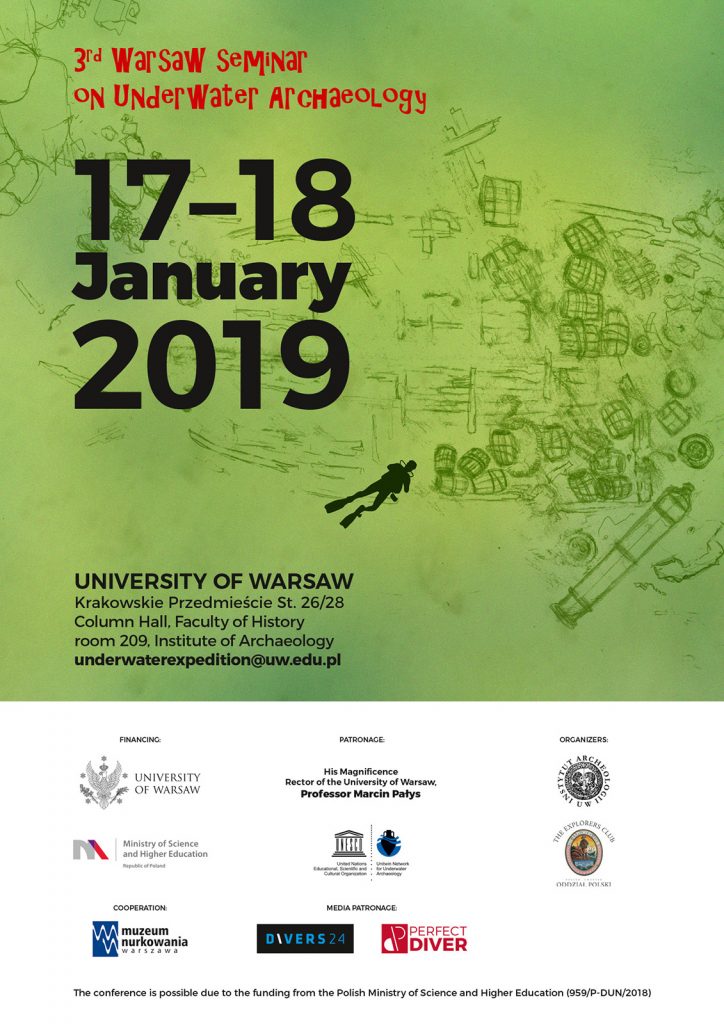
27/11/2018
Dear Colleagues, we dare to remind all the potential Participants, that if they would like to take part in all the official conference events, they are kindly asked to send the registration form until the 30th of Nov. and pay the conference fee subsequently!
Last Call!
Deadline for applications for the 3rd Warsaw Seminar on Underwater Archaeology was moved until Monday, the 4th of November, due to the 4-day holiday!
Important information on registration and invoices:
Dear Colleagues,
we would like to remind You, that all of You, who would like to participate in the whole conference (dinners, banquet, etc.) and receive the materials (even without presentation), are kindly asked to register via the application form. After the application is received, You will be sent the information concerning the conference fee (30 euros full, 20 euros reduced). ATTENTION: if You need an invoice, transferring the fee to the indicated bank account is necessary. WE CAN ONLY INVOICE THE TRANSFER SENDER.
There is also a possibility to hear the presentations free of charge, without the participation in the events.
The planned conference is the third edition of the Seminar.
The first one, which took place in April 2014, was organized for students and PhD candidates. We were pleased to host our friends and co-operators form the Ukrainian universities.
The second meeting, from nearly two years ago (January 2017), has received a large group of researchers from the universities and museums in multiple countries and issued two publications: underwater archaeology focused volume of University of Warsaw popular quarterly AD REM (pdf available here: Ad Rem, 1-4.2016) containing the conference abstracts, and the first volume of the „Światowit” Supplement Series „U” (for „Underwater”), which will be available shortly.
Great thanks for the amazing photos for two best photographers ever: Magda Sugalska and Kuba Stępnik!
- Curator of the Warsaw Diving Museum, Karina Kowalska
- Warsaw Diving Museum
- Warsaw Diving Museum
- Warsaw Diving Museum
- Warsaw Diving Museum
- Warsaw Diving Museum
- Warsaw Diving Museum
- Warsaw Diving Museum
- Warsaw Diving Museum
- Professor Vladas Žulkus
The conference is possible due to the funding from the Polish Ministry of Science and Higher Education
(959/P-DUN/2018).

